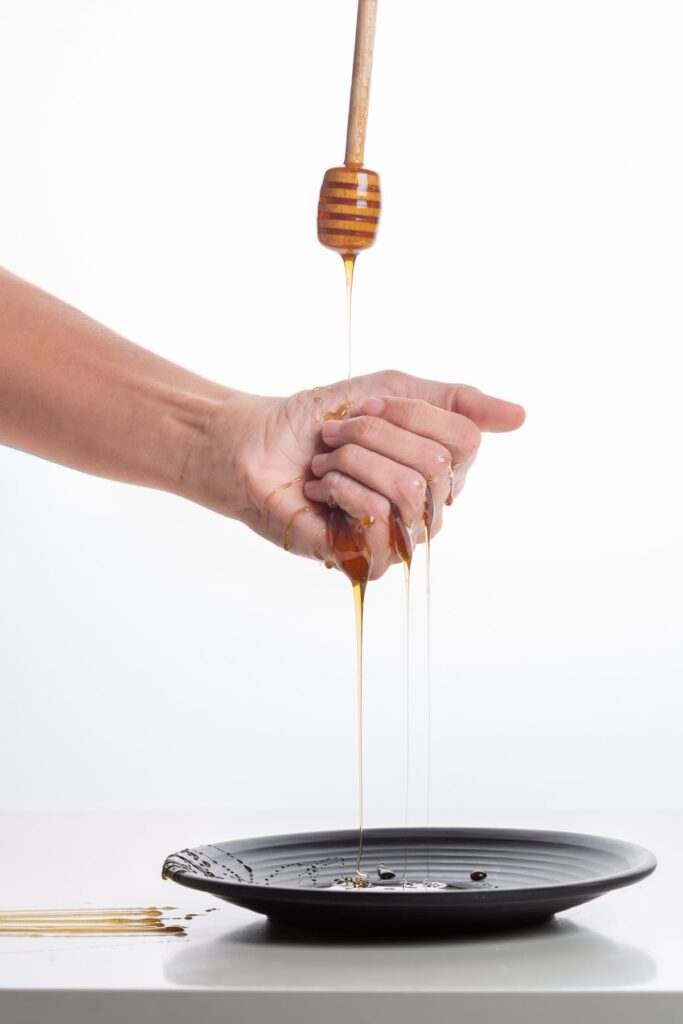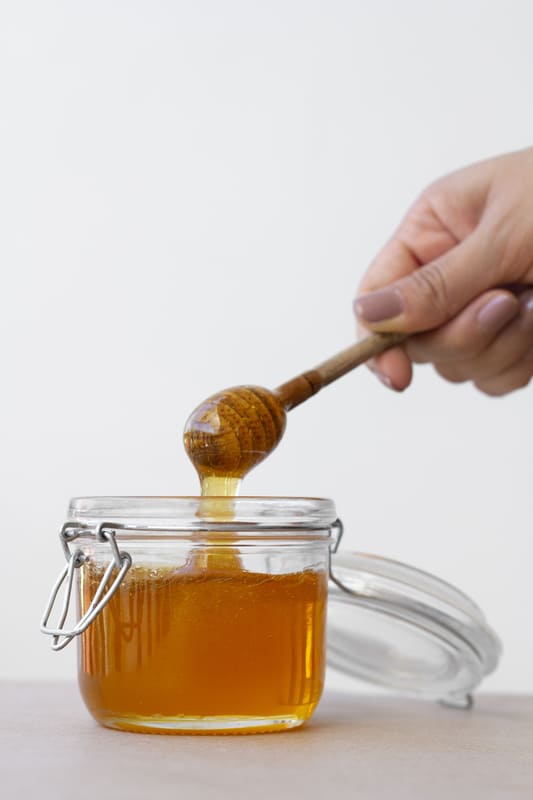Honey flows through India’s veins. Ancient Rishis praised it in the Vedas. Charaka and Sushruta, Ayurveda’s founding fathers, prescribed it as medicine. When Alexander the Great invaded, his soldiers marvelled at India’s giant honeycombs. Megasthenes wrote of honey used in royal ceremonies. In villages, grandmothers still cure coughs with tulsi and honey. At Himalayan monasteries, monks brew complex elixirs with high-altitude honey. Kerala’s tribal healers use rare stingless bee honey for eye ailments. In Mumbai’s cancer wards, doctors are testing honey’s anti-tumor properties. Modern labs analyze honey from Tamil Nadu’s Nilgiri hills, finding unique antibacterial compounds. Khadi stores sell forest honey gathered by Adivasi tribes, linking tradition to conservation. At Ayurvedic clinics in Bengaluru, honey mixed with herbs treats everything from arthritis to insomnia. India’s honey isn’t just sweet. It’s a legacy of healing, linking past to future, forest to pharmacy, myth to molecule.
In Ayurveda, honey is not just food — it’s a medicine, a preservative, and a vehicle for other herbs. It’s one of the few substances that can balance all three doshas – Vata, Pitta, and Kapha. As the revered Ayurvedic text Ashtanga Hridayam states, “Madhu tridoshaghnam” – honey pacifies all three doshas.
Ayurveda recognizes different types of honey based on the bees that produce it and the flowers they feed on. For instance, the Sushruta Samhita, an ancient Ayurvedic text, mentions eight types of honey, each with unique properties.
1. Makshika: The best honey, especially for respiratory issues
2. Bhramara: Heavy and excessively sweet
3. Kshaudra: Light and easy to digest
4. Pauttika: Dry and hot
5. Chatra: Good for bleeding disorders and worm infestations
6. Arghya: Beneficial for eye health
7. Auddalaka: Useful for skin diseases
8. Dala: Effective against diabetes and vomiting
Isn’t it fascinating how our ancestors recognized these subtle differences? It’s due to their keen observational skills and deep understanding of nature.
Honey in Ayurvedic Formulations
In my practice, I often use honey as an Anupama (vehicle) for various herbs and formulations. It’s not just a carrier; it enhances the properties of other medicines. This quality is called “Yogavahi” in Ayurveda.
For instance, I recently treated a patient with a chronic cough using a mixture of honey and sithopaladi churna. The honey not only made the medicine palatable but also enhanced its efficacy. Another patient with indigestion found relief with a simple remedy of ginger juice and honey.
Honey is also a crucial ingredient in many classical Ayurvedic formulations. Take Chyawanprash, for example. This famous Ayurvedic tonic owes much of its effectiveness and palatability to honey. The same goes for other preparations like Vasavaleha for respiratory health and Kutajavaleha for digestive issues.

The Science Behind the Sweet
Is there any scientific basis for these Ayurvedic claims? The answer is a resounding yes!
A 2017 study in the Journal of Apitherapy reviewed honey’s traditional uses and health benefits. It highlighted honey’s antibacterial, anti-inflammatory, and antioxidant properties, which align perfectly with Ayurvedic uses of honey for wound healing, digestive issues, and general health tonics.
Another fascinating aspect is honey’s prebiotic effect. A 2018 study in the journal Nutrients found that honey can promote the growth of beneficial gut bacteria. This resonates with Ayurveda’s emphasis on gut health as the foundation of overall well-being.
Honey’s Multifaceted Role
In my practice, I often explain that honey is more than a sugar substitute. It’s a complex substance with a myriad of applications:
1. As Food
Honey is recommended as a sweetener in many Ayurvedic recipes and drinks. It’s particularly beneficial for those looking to control excess Kapha in the body. However, Ayurveda advises against heating honey or using it with hot foods. This precaution aligns interestingly with modern research suggesting that heating honey can lead to the formation of potentially harmful compounds.
2. As Medicine
Honey is used in numerous Ayurvedic treatments, from wound healing to respiratory illnesses. I’ve seen remarkable results using honey-based preparations for patients with chronic coughs and skin issues.
3. As a Vehicle
In Ayurveda, we have a concept called “Yogavahi” – substances that enhance the properties of other medicines. Honey is considered a perfect Yogavahi, making it an ideal carrier for various herbal preparations.
Case Studies from My Clinic
Let me share a few interesting cases from my practice highlighting honey’s versatility.
1. The Persistent Cough
Radhakrishna, a 45-year-old software engineer, came to me with a cough that had persisted for months despite conventional treatments. I prescribed a mixture of honey and talisadi churna to be taken thrice daily. Within a week, his cough had significantly improved, and he slept better.
2. The Diabetic Dilemma
Sunita, a 50-year-old homemaker with type 2 diabetes, was surprised when I recommended a small amount of honey in her diet. I explained that pure honey has a lower glycemic index and contains beneficial enzymes, unlike refined sugar. With careful monitoring, we incorporated honey into her diet, and her blood sugar levels remained stable while her energy improved.
3. The Insomniac Artist
Priyadarshini, a 30-year-old artist, struggled with insomnia. I suggested a warm milk and honey drink before bedtime and some lifestyle changes. The results were remarkable—she reported falling asleep more quickly and feeling refreshed in the morning.
Precautions and Contraindications
In Ayurveda, honey is considered heating in nature. This means it’s not suitable for people with excess Pitta dosha or in hot climates.
Also, Ayurveda advises against heating honey or mixing it with hot foods. This is believed to create ama (toxins) in the body. Modern research has shown that heating honey can alter its chemical composition and potentially create harmful compounds.
While honey can be beneficial in small amounts for diabetics, it should be used under professional guidance. The same goes for infants under one year old, who should never be given honey due to the risk of botulism.
Honey in Modern Research
As an Ayurvedic physician, I’m always excited when modern science corroborates ancient wisdom. Recent studies on honey have been nothing short of fascinating.
1. Wound Healing
A 2011 study in the Asian Pacific Journal of Tropical Biomedicine confirmed honey’s wound-healing properties, attributing them to its antibacterial, antioxidant, and anti-inflammatory effects. This aligns perfectly with Ayurveda’s description of honey as “vraṇaropaṇa,” or wound-healing.
2. Diabetes Management
While honey is high in sugars, its composition is unique. A 2018 Oxidative Medicine and Cellular Longevity review highlighted honey’s potential benefits for diabetic patients, mainly due to its higher fructose content than glucose.
3. Weight Management
A 2011 study in Nutrition Research reported honey’s benefits in reducing body weight and lipid levels – another point where modern research echoes Ayurvedic teachings.
4. Eye Health
Ayurveda has long considered honey as “chakṣuṣya” or beneficial for the eyes. Recent studies have shown promise in using honey for conditions like dry eye disease and post-operative corneal oedema.
The Sweet Spot
As with any powerful substance, honey has caveats. In my practice, I always emphasize the importance of using honey wisely.
1. Quality Matters
Not all honey is created equal. I often advise my patients to source high-quality, unprocessed honey. The market is flooded with contaminated products, and choosing the right honey is crucial for reaping its benefits. ( pure honey costs more than 1000 rupees. )
2. Infant Safety
I make it a point to warn new parents about the risks of giving honey to infants under one year old due to the risk of infant botulism.
3. Heating Honey
Modern research supports the Ayurvedic caution against heating honey. A 2010 study in the journal Ayu reported that heating honey can lead to the formation of potentially harmful compounds.
The Future of Honey in Ayurveda
As we look to the future, the role of honey in Ayurveda seems more promising than ever. Recent research explores honey’s potential in cancer prevention and cognitive health and even as an adjunct in cancer treatment.
A 2019 study in Molecules Journal highlighted honey’s antiproliferative effects on various cancer cell lines. Another study in Frontiers in Neuroscience suggested that honey might have neuroprotective effects, potentially beneficial for conditions like Alzheimer’s.
These findings open up exciting possibilities for integrating honey into more comprehensive Ayurvedic protocols for complex health issues.
Conclusion
Honey endures. It remains a golden healing thread in India’s kitchens, ayurvedic clinics, and labs. Ancient wisdom meets modern science. Ayurvedic texts describe eight types of honey. Each has its purpose. Modern research confirms antibacterial and anti-inflammatory properties. Indian honey varieties show promise against antibiotic-resistant bacteria. Jammu’s karvi honey fights H. pylori. Gujarat’s ajwain honey soothes digestive issues. Ayurvedic practitioners still use honey as yogavahi – a catalytic agent enhancing other medicines. In hospitals, honey dressings heal diabetic ulcers. Beekeepers in remote forests preserve biodiversity, collecting rare unifloral honeys. These hold untapped medicinal potential.
From Kashmir’s acacia honey treating respiratory issues to Sikkim’s antioxidant-rich buckwheat honey, India’s diverse landscape offers a spectrum of healing nectars. Uttarakhand’s litchi honey nourishes the skin. Kerala’s rubber tree honey boosts immunity. Sundarbans’ mangrove honey adds a unique flavour to Bengali cuisine. Nagaland’s wildflower honey from Dzukou Valley carries centuries of tribal wisdom. Each state, each flower, and each bee contributes to this tradition of taste and therapy.
India’s honey is more than sweetness. It’s living history, pharmacy, and future medicine. From ancient rishis to modern researchers, the golden nectar flows on. In labs, scientists isolate active compounds. In clinics, doctors integrate honey into modern treatments. In remote villages, age-old remedies persist. Honey bridges gaps – between tradition and innovation, nature and science, past and future. Its story isn’t finished. New chapters are written daily on pollen and persistence, bees’ buzz, and research equipment’s hum. The bees work. We wonder. In each hexagonal cell, a universe of healing waits.


4 comments
Such a wonderful read ! Learnt so many new things about honey . Thanks for sharing and writing on this topic Dr 🙏🏼
thank you madam
Bee 🐝 is an exquisite chemist who has not only given us the natural sweetner but an elixir in the form of honey. Very nicely in a eloborate way you explained the various usage of honey to cure different ailments.
thank you